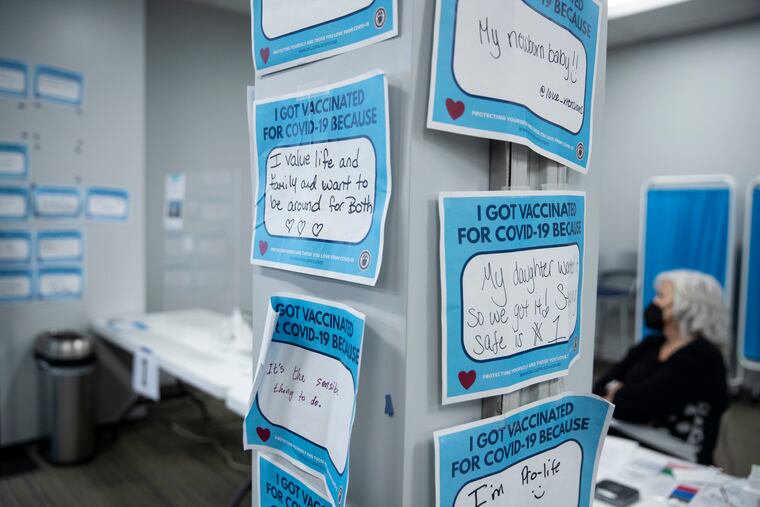The BA.2 subvariant is now dominant in the U.S., and cases are already starting to inch back up in New Jersey
As the BA.2 strain of omicron gains dominance, New Jersey is already seeing an uptick in cases that health officials attribute to the subvariant.

The BA.2 subvariant has become the dominant strain of the coronavirus in the United States and the Northeast, new CDC data showed Tuesday — meaning an uptick in cases could be around the corner, just after COVID-19 spread had reached its lowest level since July.
In New Jersey, the strain is already contributing to a slight increase in new cases, the state medical director said, though officials haven’t “yet seen any indication” it will cause a large surge.
Currently causing a surge in Europe, the subvariant — a version of omicron — is more contagious but isn’t known to cause more severe illness. Public health officials locally and nationally have said they expect an increase in infections but believe BA.2 might not cause a major wave.
The BA.2 strain accounted for nearly 55% of cases in the United States last week, the CDC data showed, with the earlier strain of omicron accounting for 40%. BA.2 has slowly been gaining dominance for the last six weeks, according to the federal data.
“Based on what we’re seeing in Europe, we’re expecting to see a rise in cases in the United States as the BA.2 variant spreads,” said Philadelphia Department of Public Health spokesperson James Garrow.
But, he noted, cases generally rise exponentially as a new strain becomes dominant, which has not yet been seen with BA.2. City health officials hope high levels of vaccination and the “extraordinarily large” number of people who were infected with omicron will help stave off a surge, though it’s impossible to predict.
» READ MORE: Is the latest COVID-19 surge in Europe coming to the U.S.?
Sequencing to determine what share of cases in Philadelphia are BA.2 is still in progress, he said. In the region containing Pennsylvania, Delaware, Maryland, Virginia, West Virginia, and Washington, D.C., BA.2 made up just over half of cases in the last week.
In New Jersey, New York, Puerto Rico, and the U.S. Virgin Islands, BA.2 accounted for 71% of the last week’s cases, according to the CDC. New Jersey’s daily average number of new cases has increased slightly over the last several days, with the daily average above 1,000 on Monday, compared with about 825 a week earlier.
“I’m optimistic that we won’t get a big surge,” said Delaware County’s public health physician, Lisa O’Mahony, also citing vaccinations and previous infections. In Delaware County, too, the percentage of tests coming back positive has increased slightly in the last week, from 2% to 2.5%, O’Mahony said. (At the height of the omicron surge in January, it was more than 40%.)
Even for people who were recently infected, the rise of the variant makes this an ideal time to get vaccinated, say O’Mahony and other public health experts. Because it takes several weeks to develop the full protection offered by the vaccine, waiting until a surge arrives to get vaccinated is too late, experts say.
» READ MORE: The FDA approves a second COVID booster for people 50 and older
The rise of BA.2 comes just as COVID-19 trends were hitting lows not seen since last summer. With the omicron surge receding nationwide, case, hospitalization, and death trends have been decreasing.
On Tuesday, the average number of new coronavirus cases in Pennsylvania was the lowest it has been since the end of July, and the rate of new cases has begun to flatten out over the last two weeks after a steep drop from the omicron surge’s January peak. The same is true in Philadelphia.
Hospitalizations of COVID-19 patients are also down dramatically, with about 700 people hospitalized in New Jersey and 400 in Pennsylvania on Monday. At the peak, nearly 8,000 and 6,300 COVID patients were hospitalized in those states, respectively, according to New York Times data.
The average number of people dying of the coronavirus each day has decreased by a quarter in the last two weeks in Pennsylvania; on Monday, it was 23 people, compared with 166 people at the Jan. 26 peak. New Jersey’s daily average was six this week; the peak was 111, according to the Times data.
» READ MORE: What can we learn from omicron? Here are 7 steps public health leaders say we should take before the next surge.
After the omicron surge, new cases in New Jersey fell slightly faster than in Pennsylvania but plateaued at a higher level. New Jersey health officials said that plateauing was likely at least partially due to the emergence of BA.2. They aren’t yet seeing indications that a large surge is coming, said New Jersey medical director Edward Lifshitz.
“Our COVID case counts are down dramatically from our winter omicron surge … about a 97% decline,” Lifshitz said in a statement. “Still, we have seen case counts plateau and even inch back up over the last few weeks.”
Encouraging people to get vaccinated, have masks and at-home tests on hand, and be prepared for the possibility that public health mitigation rules could change, Garrow said: “The most important lesson to take from BA.2 at this point is that this pandemic is not over.”
Staff writer Erin McCarthy contributed to this article.